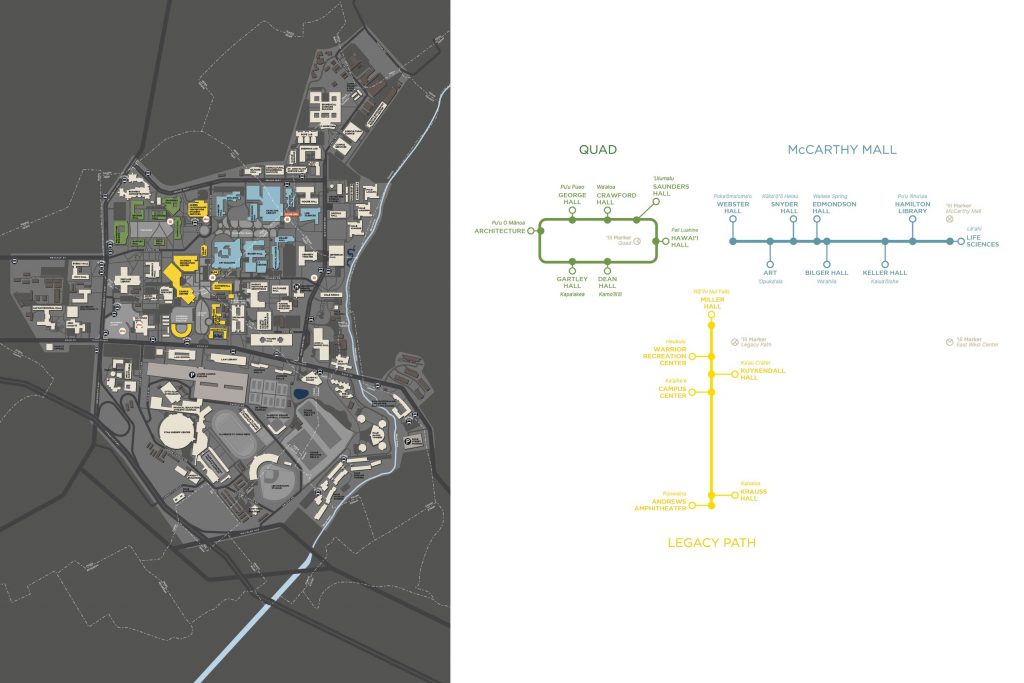
Place–Based Wayfinding
A new, bilingual signage and wayfinding system that celebrates the unique environmental, social, cultural, academic, and historic contexts of the University of Hawaiʻi at Mānoa. This system consists of new interior and exterior building signs, embedded medallions, and ʻili markers, unified around ʻōlelo Hawaiʻi. This place-based system addresses the question of “Where am I?” at multiple, intersecting levels: Where am I on campus? Where I am within Mānoa Valley and the Waikīkī ahupua’a? What is the significance of these places, and what are their stories?

Wahi Pana
Wahi pana, or storied places, are significant locations that hold an abundance of stories and memories, often passed down from generation to generation. These stories or moʻolelo communicate a history of caretaking and relationality that teach future generations about their kuleana (rights, privileges, and responsibilities) toward the ʻāina who feed them. Wahi can mean “place” while pana is often translated as the “pulse” of the heart or the “beat” in music. In this case, wahi pana can also be understood as the heartbeat of a particular ʻāina, where moʻolelo and mele are reminders of the ways in which a place is living.

ʻIli Boundaries
Situated within an ahupuaʻa are ʻili, which are usually understood as subsections of land as part of the ahupuaʻa system. The ahupuaʻa is a land division system that typically stretches from the mountain to the end of the reef barrier, following the watershed. This system fostered abundance, as it was known that those living within a well-managed ahupuaʻa would never have to leave that area for more food.

Alignment Practices
Body alignment plays an integral role in the Wayfinding system, directing viewers to various types of orientations such as toward the cardinal directions and wahi pana (significant locations) near our campus. This practice draws from heiau construction in which specific design elements were used to indicate significant celestial events. Another way these alignments manifest is through the Star Compass, an ocean-based navigational framework that tracks the rising and setting of stars and other celestial bodies. These alignments and orientations support our relationships with ʻāina and our general environment.

Watermark
The watermark pattern was inspired by kapa practices. Kapa is crafted by beating together many layers of inner bark until they are “bonded” together. As with the beating of these layers, the practice can metaphorically represent the act of bind and strengthening relationships. The watermark carries this meaning acting as a unifying motif across campus to reminds us of our community. The pattern is featured on Building Signs, the ʻIli Markers, and other installations, always in representation of the interconnectedness between our community and the ʻāina.
Signage System

Building Signage
The building sign around campus each feature the building name, the ʻili where the sign is located, a watermark pattern, and a botanical cut-out. They are paired with a medallion that is embedded into the ground, which has an embossed puʻu (pointer) directing viewers to a nearby wahi pana, or storied place.

‘Ili Marker
The ʻIli Markers around campus denote the ʻili in which they are located and signal viewers to broader cultural and geographical context. Each digital panel displays moʻolelo about the ʻili you are standing in and related knowledge or information about the campus environments.
Interior Signage
The interior signage promotes wayfinding on a more microscopic level, supporting navigation within a building. Each sign features ‘ōlelo Hawai’i, English, and braille.

Design Collaboration with Sig Zane Designs
The wayfinding system was co-designed together with Nalani Kanakaʻole, Sig Zane, and Kūhaʻo Zane of the renowned Sig Zane Designs so that each carefully-crafted element tells a story.
“The aim of each design is to reinforce cultural values. Here on campus, our goal is to remind students, teachers, and the general community, that the greater purpose is to practice culture.”
“We hope they carry forth the knowledge, even if only subliminally, the importance of place and its culture, to absorb art and stories, and to share it. We seek to educate and inspire this community. The goal is for them to develop their own communities and share this knowledge.”
— Sig Zane Designs
Contact
campusdesignlab-grp@hawaii.edu
